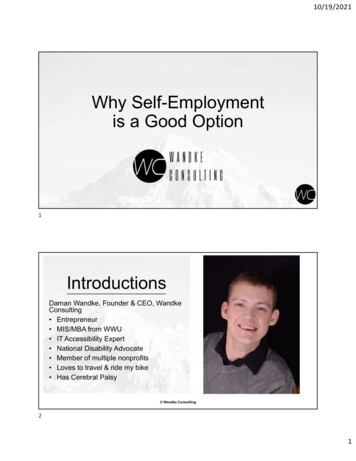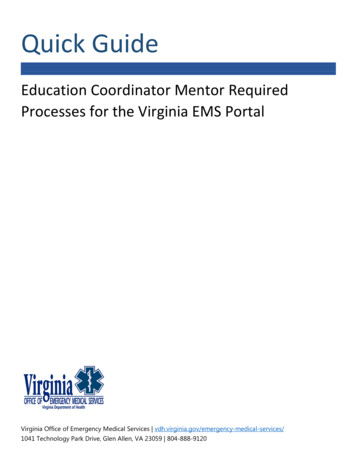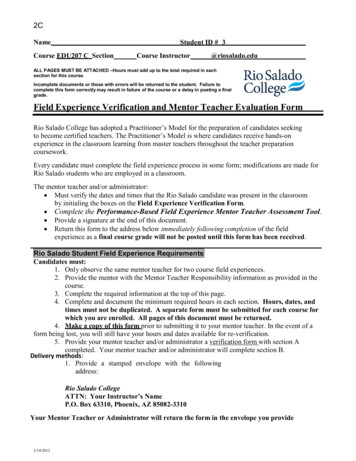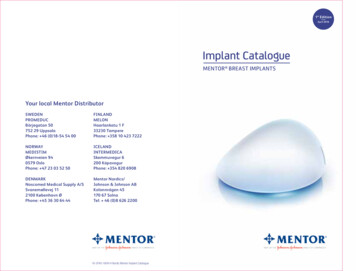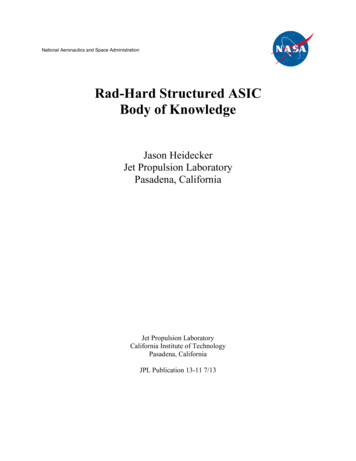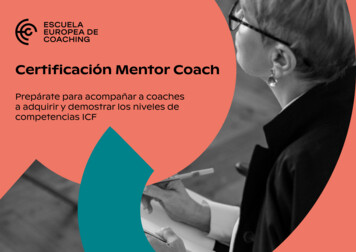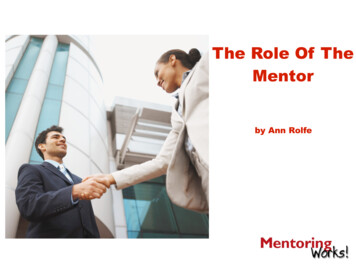
Transcription
The Role Of TheMentorby Ann Rolfe
IntroductionAnn RolfeIn our recent survey, it was clear that the role of the mentor is a topic people want toknow more about. Mentors, mentorees and mentoring program organisers are seekingclarification about what mentoring is, what mentors do and most importantly, how theydo it.Mentors assist those they mentor to achieve better outcomes but the benefits are notconfined to the two individuals. The impact of a single conversation can change thecourse of one life and therefore of many. Furthermore, learning and practicing mentoringskills makes mentors better leaders, communicators and human beings.Since 1994. I have worked with mentors and those who are mentored in Australiaand overseas. I have reviewed many mentoring programs and seen what works andwhat doesn’t. In this ebook, I’m going to share with you the ideas, models andpractical information that I have used in training people for the mentoring role.This ebook complements The Mentoring Essentials book set that details the mentoringprocess, skills and techniques. Together, they provide vital education for anyone whowants to know how mentoring works.Ann Rolfe2
People - Our Greatest AssetYou know, while priorities often shift in this climate, one thing never changes: fororganizations, people really are their greatest asset. And, while most just say that, ifyou offer mentoring you show you really mean it.Mentoring is an organizational strategy for attracting, retaining and developingpeople. It’s used for employee engagement, knowledge management and careerdevelopment. For individuals, mentoring enables personal and professionaldevelopment and in communities, mentoring gives hope, inspration and practicalsupport.Mentoring affirms our best qualities as human beings. It contributes life-enhancingknowledge and skills.At one level, mentors lead a conversation that enables another person to achieveimportant goals; at another level, they contribute to the organizational strategy forretaining and developing those they mentor. But there is something else, that notmany people know, that takes mentoring to a whole new level and exponentiallyincreases the value of mentoring. It’s an ability that some mentors have and othersdo not. It is the difference that makes the difference.If you want to know more, this book is for you.3
What Is Mentoring?You know, people often ask me about the differences between mentoring andcoaching. My short answer to that is: “It depends who you ask”. There are manykinds of mentoring, many types of coaching and many different opinions.There is a growing prevalence of mentoring and coaching both within the workplaceand outside of it. Typically, within an organization, coaching and mentoring arevoluntary roles. Mentoring is often informal, though there is increasing recognitionof the value of mentoring programs and both mentors and coaches should receivetraining for the role.There’s been a rise too in professional mentoring and coaching. There are businesscoaches and mentors, who usually take you through a systematic process ofbusiness development.There are also experts in their field who offer a kind of “I’ll show you how to dowhat I do” program that they call mentoring; And, there are accredited coachestrained in various techniques for goal achievement.The similarities and differences, in my opinion, are best understood by looking at thepurpose of conversations and the processes used to have those conversations.You need to keep in mind that we are talking about dynamic relationships thatsometimes don’t neatly fit in one box.4
Purpose & ProcessNon-directiveTrained professionale.g executive coach or paid mentorProfessional or volunteere.g personal coach or mentorTactics & techniquesStrategiesPersonal professional goalsPersonal work-life aimsPerformanceImmediatePersonalDevelopmentFuture FocusTask-specificAdvancementExpertise in a particular fieldExpertise in a particular or/paid mentorCareerDirective5
Purpose and ProcessWhere the purpose is immediate improvement of performance and the process isdirective, the conversation it is likely to be task-specific. Therefore it will mostprobably be led by a manager/supervisor, coach or preceptor who has expertise inthe relevant field.A directive approach may also be useful in future focussed conversations aimed atcareer advancement. A coach, sponsor or paid mentor with expertise in the fieldwould be appropriate.A non-directive process could aim to improve performance. In this case it wouldfocus on the tactics and techniques needed to achieve personal professional goals.Such a process would most likely be facilitated by a trained professional such as anexecutive coach or paid mentor.For the purpose of career development, a conversation using non-directive processwould help the person identify and implement strategies to achieve their personalwork-life aims. They might use a professional, or a volunteer, as a personal coach ormentor.Developmental relationships are rich and complex and not static and usuallyencompass more than one approach. Personally, I believe that it is more importantthat both parties in a developmental relationship understand and agree about thepurpose and process of their conversations, rather than get hung up whether it islabelled “mentoring” or “coaching”.6
Mentoring In TheWorkplaceMentoring in the workplace is a confidential conversation about career-relatedissues. Mentoring is voluntary and may be informal or part of a planned program.Usually, the mentor is “off-line” which means not in a direct line of authority,someone who does not supervise or manage the day-to-day performance of theperson being mentored.Most of the time, the process is toward the less directive end of the scale so thatmentorees take self-responsibility for decisions and actions. This produces personalgrowth for both parties, specific, beneficial, individual results and strategic outcomesthat that add value to the bottom line of organizations.Mentoring enables people to set and achieve their own goals, explore issues orproblems and make informed decisions about how to handle situations or managetheir career.Where mentoring is part of a structured program, pairs are matched and resourcessuch as materials, time and funds are allocated. A coordinator manages the programand maintains communication with all involved.Various forms of ongoing support isgiven to participants. This might include online and/or live training, books, tips,forums and review sessions. The aim is to achieve strategic organizational outcomesas well as produce benefits for individuals. An evaluation process measure thedegree to which objectives are achieved.7
A Mentor’s RoleElicitChallengeSupportImpart8
What Do Mentors Do?Now I want to start to share with you the secret that transforms mentoring. Thisthing that not many people know about mentoring; the ability that some mentorshave and others do not; the difference that makes the difference.A Mentor’s Role can be illustrated in a two dimensional model that again hinges ofpurpose and process. Mentors elicit information, so they first build rapport, askquestions, listen and ask more questions. They listen with their ears, eyes, both sidesof their brain, mind and body - they listen with their heart as well as their headbefore they impart information. Mentors share their knowledge, experience, ideasand opinions when invited and when it is appropriate to do so.Often people need support from the mentor, validation, affirmation butsometimes it is challenge that brings out our best. So a mentor is an empathetically.Yet, on occassion they need to be able to give the mentoree a nudge bydisagreeing, giving a different point of view or suggesting a course of action.However, in my experience, mentors can be too quick to give solutions, opinions oradvice. Here’s why it is important NOT to be too quick with answers.9
Conversations That CreateInsightThe crew of the Titanic found out the hard way, that nine-tenths of an iceberg is belowthe surface and in a way, people are like icebergs. Nine-tenths of a person is notimmediately visible.Take a moment to draw an iceberg with the tip above the water and the bulk below.Now label what’s above the surface “conscious” and what is below “subconscious”.You can observe what people do and say but why they do it, their real needs, wants andmotivation are frequently not obvious even to themselves! They may not be aware ofthoughts, emotions, values and beliefs in their subconscious but these can be brought tothe surface through conversations.When you ask questions and listen, you not only elicit information you don’t know,but your questions often allow the other person to articulate information theydidn’t know! You enable them to bring to conscious awareness that which had beenbelow the surface dwelling in their unconscious. The conversation creates insight.10
Mentoring allengeSoundingBoardCoachRole ModelImpartLink Ann Rolfe, Mentoring Works
Mentoring RolesMentoring conversations are confidential so the mentor becomes a confidante,someone who is trusted enough to share dreams, aspirations and issues. Sometimes, allpeople need is quiet listening. Simply speaking their thoughts out loud generates insight,solutions or actions that become obvious. So the mentor, just by being supportive is acatalyst for change. A mentor is often a sounding board so that the mentoree can“bounce ideas off them”. Mentors often link their mentoree to other resources orpeople that can provide information. The mentor doesn’t have to have all the answers!The mentor is a role model, their behavior and approach provides an example.Coaching may be a subset of mentoring. If asked, a mentor may help the mentoreedevelop specific skills and abilities. People who want mentoring sometimes want anadviser. They value the knowledge, ideas and opinions that come from your experiencebut as mentioned before, don’t be too quick to assume this role. A mentor is also aguide. I believe that a mentor has what I’d call a “duty of care”. That is, if the mentoreeintends action you know is dangerous, share your concerns with them. A mentor impartsinformation. However, it is always the mentoree that decides, acts and produces theoutcome.12
How They Do ItGordon Crawford, MentorForrester Crawford InternationalNow we are getting to the heart of the secret. The skill-set, that if used in mentoring,benefits mentors as much as those mentored, and increases value to the organization,because it creates insight, creativity and critical thinking, which is an awesomecombination. It’s not something you can easily teach but it is something you can helppeople learn.You need to know it and, guess what? The full awareness of this secretand its significance became apparent, as my mentor, Gordon Crawford, and I talkedabout the nature of mentoring!Gordon says, “The principle objective of mentoring for me is to help people achievetheir life goals. Note, their life goals, not mine, and we are all different. To do that wehave to ask them to explain those goals; and, ask how they see them being fulfilled.Mentoring and coaching some thirty plus CEO’s, I can tell you they get distracted andlose their way, managing busy, successful businesses. As their mentor, I have to keeptheir lives on track. I need to know their values and ensure that their actions arealigned to them. As they describe what is going on in their lives, I am looking for gapsbetween life goals, values and what they are focussing on consciously versussubconsciously. This means I am often listening for what they are not saying and nottalking about. That process is hard and needs the mentor to be fully present andtotally focussed on the mentoree - I’m not sure how mentors can do that withouttop-class training. Nowhere in this process am I telling them what to do. Where I haverelevant experience however, I will share what I do and why that works or doesn’twork for me.My mentoring sessions always end with them writing an action plan with target dateswhich I will review with them at the next meeting.”13
A Mentor Is Someone WhoAsks questions - to draw people out;Listens without judgement - does not impose their own value-judgements onanother;Probes without prying - is able to ask hard questions, questions that go deep andprobe the subconscious, without crossing the line and being to personal;Expands ideas without instructing - can suggest alternatives, explore possibilitieswithout telling people what to do; andDevelops rapport and trust - so that confidential conversations are possibleThe objectives of mentoring are to increased self-awareness and personal development toenhance critical and creative thinking. To help people focus on outcomes. They will developindependent decision-making and use a reflection - decision - planning - action cycle.14
Two Types Of MentoringLeonie StanfieldCareerTalkThere are two main types of mentoring. There are those who mentor fromcompetence; and then there’s those who mentor for challenge. The majority ofpeople mentor from competence. They share their expertise.My colleague, Leonie Stanfield of Careertalk, is completing her masters in careerdevelopment, and believes that mentoring from competence reinforces the mentor'sself-image as a good listener and someone who gives. Mentoring reinforces theiridentity and reaffirms their confidence. Mentoring from competence allows one toremain in the comfort zone.A different person values the challenge of learning and self-discovery. It's "a braveand rare person who is willing to experience mentoring from a more vulnerableplace." Leonie says.This kind of mentor steps into the unknown, trusting the process. They understandthat in facilitating another's journey to insight they uncover their own. In exploringthe needs and goals of another, they reveal their own and, in eliciting the values ofanother they examine their own. For them, mentoring is not so much an affirmationas mutual growth. They do it because they are committed to joint learning. They arelearning about themselves at the same time as they assist someone else.It is not unusual for volunteer to begin with the mentoring from competence modeland move to mentoring for challenge. A shift takes place when mentors areequipped with a process for leading a conversation that does not depend onexpertise in their field to produce outcomes.15
Courageous MentoringA conversation that does not depend on expertise in their field toproduce outcomesGordon Crawford, MentorForrester Crawford InternationalGordon comments: “I’m working with CEOs. I’m not smarter than them, in manycases, they’re smarter and more experienced than me and it’s essential that I avoidlimiting their progress by what I know. So I am willing to go into the unknown. it tookme a while to learn that and to do it I had to ask tough questions, questions to whichI have no idea what the right answer is. When they answer, I follow up with ‘and howdoes that work for you?’ In explaining their answer, the mentoree will either confirmthe validity of their response or realise that they’re on the wrong track.In this process, as a mentor, we can change people’s lives in extraordinary and excitingways and way beyond our own ability to advise someone based on our ownknowledge or experience. The bonus for the mentor is that they will learn things tooand can apply these things to their own lives. I think this raises the level of qualitymentoring far above the teacher or the coach where the teacher or coach is thefountain of knowledge whereas the mentor is really the fountain of the process.”16
The Mentoring ConversationCurrent Reality“Where am I now?”“How am I doing?”4Action3“How do I get there?”1Reflection2“Where do I want to be?”Informed Decisions Ann Rolfe, Mentoring Works
The Mentoring ConversationThe mentoring conversation is a framework that provides the security that thementoring from competence group need and a springboard that will inspire thosewho will mentor for challenge.The Mentoring Conversation is a model based on learning theories such as thosedeveloped by David Kolb, Honey and Mumford, and Bernice McCarthy, as well asclassic problem solving and strategic planning and decision-making processes.The mentoring conversation aims at facilitating self-development. It is based on fourquestions:1.Where am I now?2.Where do I want to be?3.How do I get there? And4.How am I doing?The mentor firstly facilitates reflection and the exploration of options. Next, thementor assists the mentoree to make informed decisions, set goals and formulatepractical strategies to achieve them. The mentor then encourages and supports thementoree as they implement their plan.When a mentor models and leads the mentoring conversation as described, thementoree learns a valuable problem solving and decision-making process that can beapplied in any situation. Thus, a mentor assists not only with immediate needs butalso equips the mentoree to deal with future issues.18
Many Ways To MentorInformal - a casual conversation or an observed role-modelA Structured Program - pairs are introduced and supportedA One-to-one Relationship - pairing mentor and mentoreeReciprocal Mentoring - two people take turns in mentoring each other as peersReverse Mentoring - the more junior person as the mentorCascading Mentoring - a top-down process of mentoring involving people at eachlevel of the organizationGroup Mentoring - one mentor can be teamed with several mentorees who meetat the same timeMentoring Round-Tables - peers meet as a group to explore a topic, issue orgoalMentoring Circles - a facilitator meets with four, six, eight or ten people, each ofwhom is both mentor and mentoreeMastermind Mentoring and Business Coaching - a person with significantexpertise or guru status in a particular field takes on one who wishes to learn tobecome like the master or do what they do19
In Summary .The key points that I hope you’ll take away from this ebook are these: There’s no need to get too hung up on whether it’s called mentoring or coaching aslong as the people involved understand and agree the purpose and processes of therelationship;Ann Rolfe Mentoring affirms our best qualities as human beings. It contributes life-enhancingknowledge and skills. Mentoring is astrategy that produces organizational outcomes Mentors elicit and impart information, they support and challenge people Mentoring conversations create insight, they create conscious awareness of whatotherwise might remain beneath the surface. There are many mentoring roles because mentoring is a dynamic relationship You can mentor from competence and stay in the comfort zone and you can developskills and confidence to mentor for challenge A skilled mentor can leadsconversation that does not depend on expertise in theirfield to produce outcomes. It takes courage to ask questions that you don’t know the answer to, yet itempowers both parties The Mentoring Conversation is a framework for any type of mentoring There are many ways to mentor20
Mentoring WorksThis ebook may not be reproduced without permissionCopies may be purchased fromwww.mentoring-works.comContact us for a license to print multiple copiesann@mentoring-works.comPhone 61 2 4342 2610Mentoring ResourcesMentoring Works provides many free resources as well as products forsale, services and consulting to ensure mentoring for better outcomes.Visitour website or contact us for more .comPhone 61 2 4342 2610
You know, while priorities often shift in this climate, one thing never changes: for organizations, people really are their greatest asset. And, while most just say that, if you offer mentoring you show you really mean it. Mentoring is an organizational strategy for attracting, retaining and developing people.



